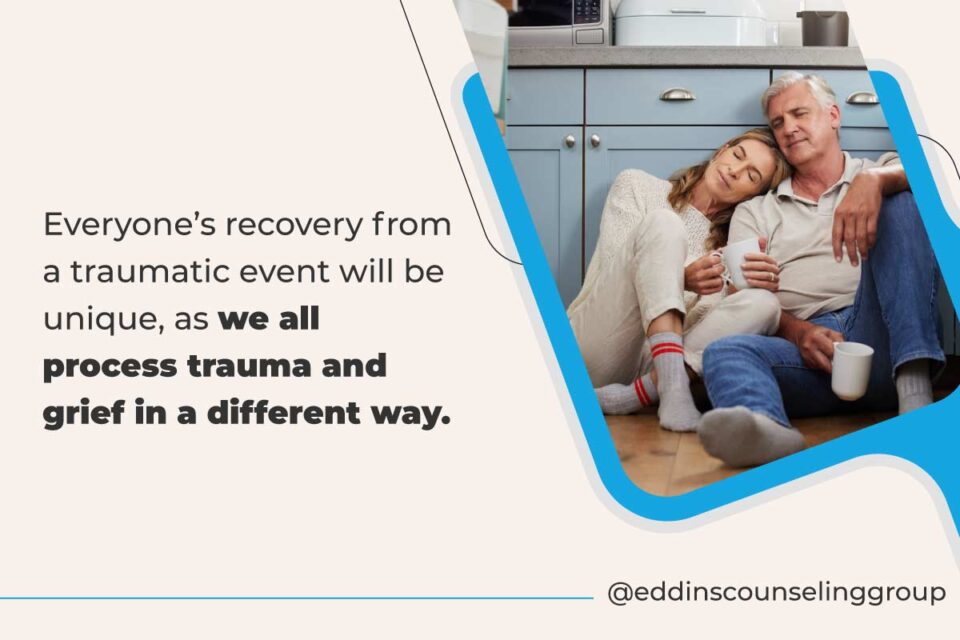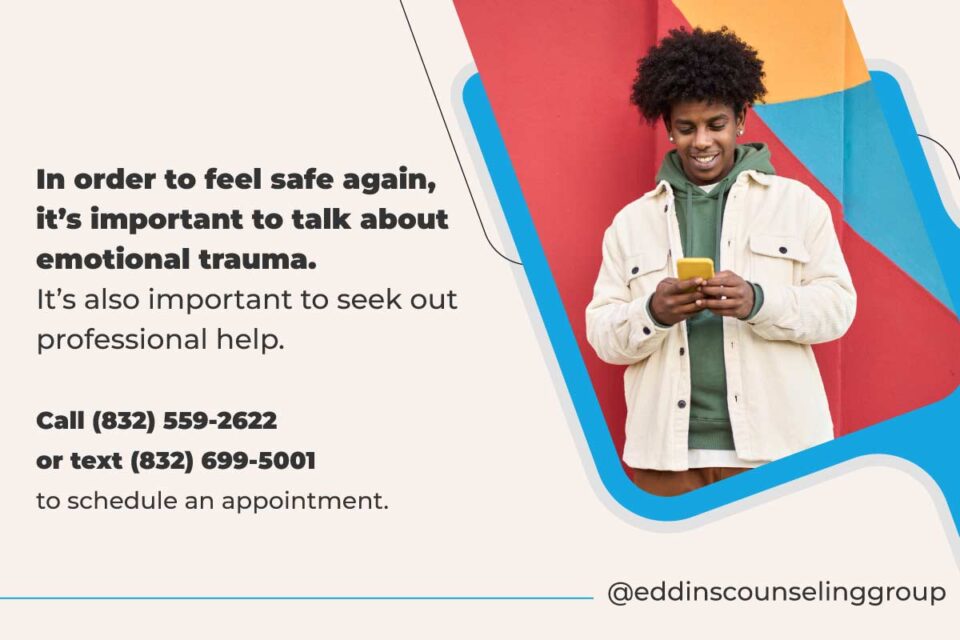May 8, 2023
How To Feel Safe: 6 Best Strategies To Feel Safe Again
Written by Sara Lane
Posted in Trauma, Grief & Loss and with tags: PTSD/Trauma, abuse, heal from trauma, mental health

In today’s world, there are unlimited reasons people can feel unsafe.
Our Houston therapists hear this problem every day & they have written this article to help you finally feel like you are safe again.
The world is full of chaos.
As humans in the modern age, being surrounded by a stifling cacophony of fear, triggers, and devastation can inundate our central nervous system.
Over time, the continued sense of being ‘on edge’ and fearing the worst can take its toll. Mental health experts now classify this as a form of trauma.
What to Do When the World is Intimidating
For some, this feeling of being unsafe stems from a specific traumatic event. The clear and present danger that they felt is marked in their body and can manifest in a variety of ways.
Some examples of fear-inducing trauma include:
- Active combat
- Sexual assault
- Military training & experience
- Natural disasters (such as a hurricane, fire, flood, tornado, or earthquake)
- Witnessing someone else getting hurt or killed
- Hospitalization
- Sudden death of a loved one
- Domestic violence
- Car accidents (being in one or witnessing one)
- Traumatic loss
These are just a short list of examples of various types of situations that would cause trauma.
If your experiences have left you feeling unsafe – even if the situation itself wasn’t unsafe – you could be reeling from a traumatic event.
Your body is on the lookout to find any potential dangers to your mental and physical health.
Even if an event didn’t necessarily pose a threat to you, some situations will still be classified as ‘dangerous’ and ‘must be avoided at all costs’ by your central nervous system.
We call this response trauma, because your body is still responding to an event that your central nervous system believes is a threat to you currently.

How Trauma Starts
As we mentioned, trauma can stem from a multitude of experiences.
- Sometimes these experiences are repeated over and over again, but
- Sometimes it only takes one negative event to cause significant trauma to someone’s mental health.
The amygdala – the fear-processing part of the brain – looks out for any dangers that pose a threat to you.
When you experience a traumatic event such as those listed above, your amygdala processes that information and stores the details in your long term memory. This is why survivors sometimes remember vivid details about the event (colors, clothing, smells, and other sensations).
The opposite is also true: sometimes the brain shuts out all conscious memory surrounding the event to protect itself from the trauma hidden there.
Those memories may still be hidden under the surface, and come to consciousness through bad dreams, trauma responses, and other triggers.

Everyone’s recovery from a traumatic event will be unique, as we all process trauma and grief in a different way.
Below, we’ll list some best practices for moving forward and finding normalcy again:
1. Normalize the Change
You may not be able to do those things because you experience such negative reactions from the triggers.
Be honest with yourself and your support system. When things don’t feel right, have the courage to tell people you can trust that this process is hard.
The recovery process brings many emotions and changes. It may not feel like you’re living your normal life for a while, and that’s ok.
Keep being honest with your emotions – including the things you feel like you can do and the things that feel overwhelming. Take all the time that you need.
2. Express Your Emotions When You Can
Find a support system of people you can trust.
When you are experiencing big emotions or physical reactions during the recovery process, speak to your support system and allow them to help you.
A caring hug and a listening ear can go a long way towards helping our brains reprocess the trauma and feel safe again in our environments.
3. Ask for Help
This can be incredibly helpful for anyone going through the trauma recovery process. However, for independent people it’s no small feat.
Do your best to allow people in your life to help you. Give them the opportunity to walk with you emotionally and to be there for you when you need them.
Your support system may not know how to help. Simply seeing a loved one in pain is difficult, especially when we can’t take their pain away.
That’s why it’s good to tell your support system what you need from them. Your suppose system may want to help you by:
- Delivering a meal
- Supporting you during visits to your doctor or attending other appointments
- Talking over a cup of coffee
- Being available at a certain time to call or text if you anticipate a trauma response
- Taking on some of your usual responsibilities for a while
- Space from other people for a short period of time
Giving your support system a task helps them feel as though they can relieve some of the pain you’re experiencing and helps them feel useful.
It may be difficult to ask for help, but in the long run it can help both you and your loved ones.
If you haven’t reached out to a mental health professional yet, we highly recommend you start there. They’ll be able to give you a form of mental first aid as you start your recovery process.
Go to a therapist you can trust with your story and who you feel comfortable with. Our counselors at Eddins are more than willing to help guide you through this process.
4. Give Yourself Time
If after a weekend, or a month, or 10 years, you find yourself pushing back against a traumatic trigger, you may feel discouraged or angry that your recovery time isn’t happening on your timeline.
As difficult as it is, give yourself time. Allow your body to take the time it needs to reprocess your trauma responses.
The spiritual process of healing may take time, and that’s ok. Acknowledge the ways you’re experiencing negative trauma responses.
As you work towards recovery – through counseling, medication, cognitive reprocessing, and positive self-care – be gentle with yourself.
There’s no deadline that you need to be finished with your trauma responses. Allow yourself the time you need, and be kind to yourself along the way.
5. Stick to a Routine
When you’re first starting to come back from a traumatic experience, you may not know where to start. So much may feel different. You may feel like a different person yourself, and may not know if your old life will be something you can come back to.
Those are normal experiences. As you navigate through the first few weeks and months of recovery, do your best to stick to a routine.
You may find that keeping yourself busy with work, school, your family, fitness and exercise, and other activities helps keep your mind off of the trauma you’re walking through.
It can be really difficult to stick to a routine, especially if you’re experiencing severe depression or anxiety side effects from the trauma.
However, it can significantly improve your recovery process going forward. Find the things you can do and do your best to stick to your schedule.
Giving yourself lots of grace along the way…
6. Find Relief for the Symptoms
Following a traumatic event, you may notice a lot of changes surrounding your mental and physical health. For example, you may notice that you’re feeling more tired, lonely, or sad throughout your day.
Other common mental and physical side effects of trauma include:
- Depression
- Generalized anxiety disorder
- Anxiety around specific circumstances or environments (triggers)
- Numbness
- Inability to cry or feel emotions
- Crying a lot
- Not knowing how to express your emotions
- Feeling unsafe emotionally or physically (even with people you don’t think are dangerous)
- Significant emotional pain
- Phantom limb pain
- Many other emotional and physical symptoms
These are common, normal symptoms of going through a traumatic experience. But you don’t have to grin and bear them.
You can think of your side effects as an illness (like a migraine or a broken arm) that you need to treat.
When you’re not sure where to start, start with the symptoms that plague you the most.
These could be mental – sadness, fear, an uncertainty of the future, inability to do the tasks you used to. Or they could be physical – hyperventilating, tensing your body when you’re in public, hyperfocus/hypervigilance.

Your Trauma Healing Journey
Reach out to your family doctor or therapist if you’re experiencing these symptoms, as they may be able to give you medication or exercises that will make these less severe.
Trauma is still a process to recover from, but you don’t have to suffer alone.
Our trauma certified therapists at Eddins Counseling Group are here to support you on your trauma healing journey.
Call (832) 559-2622 or text (832) 699-5001 to get started today.
Grounding & Self Soothing
Get instant access to your free ebook.
















